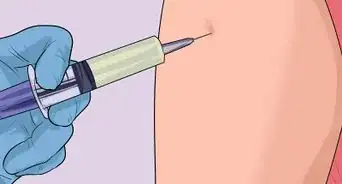This article was medically reviewed by Lacy Windham, MD and by wikiHow staff writer, Janice Tieperman. Lacy Windham, MD, is a Board-Certified Obstetrician & Gynecologist in Cleveland, Tennessee. Dr. Windham attended medical school at the University of Tennessee Health Science Center in Memphis. Her residency was completed at Eastern Virginia Medical School in Norfolk, Virginia. She was the recipient of multiple awards during her residency training, including Most Outstanding Resident in Maternal Fetal Medicine, Most Outstanding Resident in Oncology, Most Outstanding Resident Overall, and Special Award in Minimally Invasive Surgery.
There are 15 references cited in this article, which can be found at the bottom of the page.
wikiHow marks an article as reader-approved once it receives enough positive feedback. In this case, several readers have written to tell us that this article was helpful to them, earning it our reader-approved status.
This article has been viewed 1,263,272 times.
You’ve noticed some recent discomfort down there, but aren’t totally sure what’s going on. If you started feeling badly about 1-3 weeks after being sexually intimate with a partner, chlamydia could be the culprit.[1] Although it’s a well-known Sexually Transmitted Infection (STI), this bacteria is very easy to treat and eliminate—the key is knowing what to look for. We’ve outlined all the common symptoms of chlamydia in women, so you can make the best, most informed decision about your sexual health.
Things You Should Know
- Vaginal discharge, pain during urination, pain during sex, and rectal pain and bleeding are all signs of chlamydia.
- Back and pelvic pain, a sore throat, a fever, and mild nausea can also be signs of chlamydia.
- Get tested for chlamydia at your local health clinic before you experience symptoms.
- Treat chlamydia as soon as possible with oral antibiotics. To prevent it in the future, use condoms or dental dams whenever you’re sexually intimate with someone.
Steps
Common Genital Symptoms
-
1
-
2Pain during urination and/or sex
Women fighting a chlamydia infection sometimes experience a burning feeling while they pee. They may also feel a lot of pain and discomfort while they’re being sexually intimate with their partners.[6]- If you feel pain or discomfort during sex, put things on pause until you can get tested and checked out by a doctor.
Advertisement -
3
Other Bodily Symptoms
-
1Lower back and lower abdominal pain
If the chlamydia infection reaches the fallopian tubes (the tubes that connect the uterus and ovaries), you might experience pain in your lower back and lower abdomen. A fever or nausea can also accompany these symptoms.[9]- Keep in mind that back pain, abdominal pain, nausea, and fever are associated with a lot of different illness, so they aren’t undeniable proof of chlamydia. For instance, colds, the flu, mononucleosis, bronchitis, and UTIs are just a few common fever causes.[10] Headaches, dizziness, allergies, anxiety, and many, many other issues can cause nausea.[11]
-
2Sore throat
Chlamydia infections can flare up in the throat if you’ve recently had oral sex. However, most people don’t detect any symptoms with throat-based chlamydia infections.[12]- Even if you do have a sore throat, it doesn’t necessarily mean you have chlamydia—the cold, the flu, allergies, and many other factors can cause it.[13]
-
3Pink eye
If infected semen or vaginal fluid gets in your eye, it can lead to conjunctivitis (pink eye).[14] Redness, itchiness, and crusty discharge are all routine symptoms of pink eye, but it’s best to get an official diagnosis from your doctor before you start treatment.[15]- In addition to bacteria (like chlamydia), viruses can also lead to pink eye.
Risk Factors, Treatment & Prevention
-
1You might be at risk for chlamydia if you’ve had unprotected sex. Chlamydia only spreads through semen and vaginal fluids. So, if you’ve recently had any type of unprotected sex (regular intercourse, anal sex, oral sex, etc.), you could be at risk for infection.[16]
- Sex toys can spread chlamydia if an infected individual uses them.
- Chlamydia is only spread through sex. You can’t get infected via kisses, sneezes, coughs, or sweat. You also won’t catch chlamydia by using a public restroom or by sharing a beverage or meal with someone who has chlamydia.
-
2Get tested for chlamydia to get an official diagnosis. Many people don’t notice any physical symptoms after getting infected with chlamydia.[17] Because of this, it’s important to get tested if you (or your partner) recently had sex without protection, if your condom broke during sex, or if you just want to be on the safe side.[18] To get started, stop by your doctor’s office or a local health clinic—the testing process typically involves a urine sample and/or a swab of your genitals.[19]
- Give the doctor a brief run-down about your sex life so they know where to test. If you engage in anal and oral sex as well as intercourse, they might want to swab your throat and rectum as well as your genitals.
- Always get tested for STIs (including chlamydia) before you start getting intimate with a new partner.[20]
-
3Take antibiotics to treat the chlamydia. Chlamydia is a bacterial infection, which means it can be easily cleared away with a round of antibiotics.[21] After testing, a doctor will give you a prescription for antibiotics—this might be azithromycin, which is taken just once, or doxycycline, which is taken for a full week. Follow the dosage instructions carefully to make sure the infection completely goes away.[22]
- Once you’ve completed your antibiotic treatment, wait at least 1 week before getting sexually intimate again.[23]
-
4Prevent future chlamydia infections by practicing safe sex. Abstinence is the best, most foolproof way to avoid getting chlamydia in the future, but it’s not your only option. Make sure that your or your partner uses a condom whenever you have sex—this greatly lowers your risk of catching or spreading STIs like chlamydia.[24]
- Stay safe during oral sex by using a dental dam.
Warnings
- Teens and young women (between ages 15 and 24 specifically) are most likely to get infected with chlamydia.[25]⧼thumbs_response⧽
- Not a lot of women experience chlamydia symptoms, so it’s super important to get tested. Without treatment, chlamydia can snowball into serious problems like Pelvic Inflammatory Disease (PID) or infertility.[26]⧼thumbs_response⧽
References
- ↑ https://stanfordhealthcare.org/medical-conditions/sexual-and-reproductive-health/chlamydia/symptoms.html
- ↑ https://my.clevelandclinic.org/health/symptoms/4719-vaginal-discharge
- ↑ https://my.clevelandclinic.org/health/diseases/4023-chlamydia#symptoms-and-causes
- ↑ https://stanfordhealthcare.org/medical-conditions/sexual-and-reproductive-health/chlamydia/symptoms.html
- ↑ https://www.nhsinform.scot/illnesses-and-conditions/sexual-and-reproductive/chlamydia
- ↑ https://medlineplus.gov/chlamydiainfections.html
- ↑ https://www.healthlinkbc.ca/healthlinkbc-files/chlamydia
- ↑ https://my.clevelandclinic.org/health/diseases/4023-chlamydia#symptoms-and-causes
- ↑ https://www.ashasexualhealth.org/chlamydia-101/
- ↑ https://my.clevelandclinic.org/health/symptoms/10880-fever#possible-causes
- ↑ https://www.mayoclinic.org/symptoms/nausea/basics/causes/sym-20050736
- ↑ https://my.clevelandclinic.org/health/diseases/4023-chlamydia#symptoms-and-causes
- ↑ https://www.mayoclinic.org/diseases-conditions/sore-throat/symptoms-causes/syc-20351635
- ↑ https://my.clevelandclinic.org/health/diseases/4023-chlamydia#symptoms-and-causes
- ↑ https://www.mayoclinic.org/diseases-conditions/pink-eye/symptoms-causes/syc-20376355
- ↑ https://my.clevelandclinic.org/health/diseases/4023-chlamydia#symptoms-and-causes
- ↑ https://medlineplus.gov/chlamydiainfections.html
- ↑ https://www.nhs.uk/conditions/chlamydia/diagnosis/
- ↑ https://www.plannedparenthood.org/learn/stds-hiv-safer-sex/chlamydia/should-i-get-tested-for-chlamydia
- ↑ https://www.health.ny.gov/publications/3835.pdf
- ↑ https://www.health.ny.gov/publications/3835.pdf
- ↑ https://my.clevelandclinic.org/health/diseases/4023-chlamydia#symptoms-and-causes
- ↑ https://www.health.ny.gov/publications/3835.pdf
- ↑ https://www.health.ny.gov/publications/3835.pdf
- ↑ https://my.clevelandclinic.org/health/diseases/4023-chlamydia#symptoms-and-causes
- ↑ https://www.plannedparenthood.org/learn/stds-hiv-safer-sex/chlamydia/chlamydia-symptoms
About This Article
It's natural to be stressed if you think you might have chlamydia, and although it's usually symptomless, there are a few symptoms to watch out for so you can get diagnosed and treated early. If you experience any unusual discharge, gradually worsening back or abdominal pain, fever or nausea, you may have chlamydia or another sexually transmitted infection. Other symptoms include pain during urination or intercourse, any bleeding after sex, or a sore throat after oral sex. Because chlamydia is often symptomless, you should get tested if you've had unprotected sex recently just to make sure. Don’t worry if you think you may have chlamydia, since it is curable. Just visit your doctor or a local sexual health clinic, like Planned Parenthood to get tested. If the test is positive, you'll usually just need to take some tablets to get rid of it. To learn who is most at risk of chlamydia and more advice from our Medical co-author, read on.
-Step-2-Version-4.webp)
-Step-3-Version-4.webp)
-Step-4-Version-4.webp)
-Step-5-Version-4.webp)
-Step-6-Version-4.webp)
-Step-7-Version-4.webp)
-Step-8-Version-4.webp)
-Step-9-Version-4.webp)
-Step-10-Version-4.webp)


-Step-10.webp)
-Step-17.webp)


-Step-11-Version-2.webp)



-Step-10.webp)
-Step-13.webp)















-Step-10.webp)
-Step-17.webp)



































Medical Disclaimer
The content of this article is not intended to be a substitute for professional medical advice, examination, diagnosis, or treatment. You should always contact your doctor or other qualified healthcare professional before starting, changing, or stopping any kind of health treatment.
Read More...